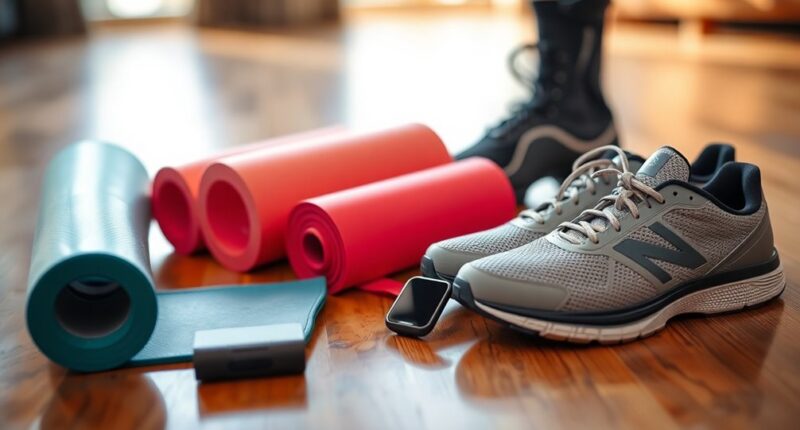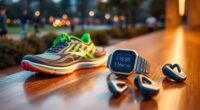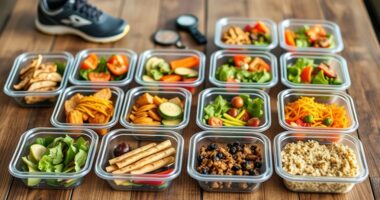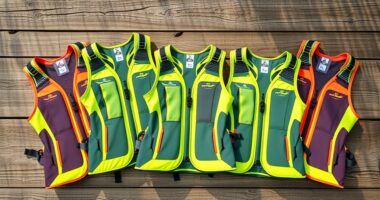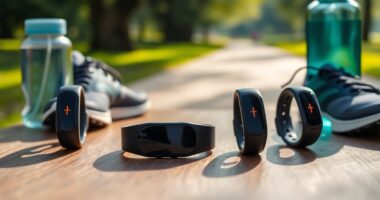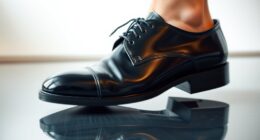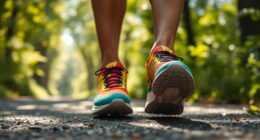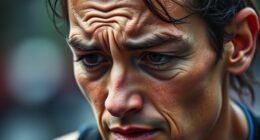If you're looking to get back on track after an injury, I've found some fantastic rehabilitation gear just for you. The Running Tether connects visually impaired runners with guides, while the REAQER Pedal Exerciser Bike is perfect for low-impact workouts. Don't forget about the Bodyprox Calf Support Brace for recovery and the Water Gear Runner Floatation Belt for Aquatic workouts. These tools can really make a difference in your rehabilitation journey, and there's plenty more to explore.
Key Takeaways
- Select gear that enhances support, such as the Bracoo Knee Support Brace, to maintain alignment and reduce strain during rehabilitation.
- Incorporate low-impact exercise solutions like the REAQER Pedal Exerciser Bike to promote recovery while minimizing joint stress.
- Utilize recovery tools such as CanDo Foam Rollers for effective muscle recovery and myofascial release post-exercise.
- Choose adjustable and breathable gear, like the Bodyprox Calf Support Brace, to ensure comfort and fit during rehabilitation sessions.
- Explore feedback on various products to assess durability and performance, guiding your selection of the best rehabilitation gear.
Running Tether Recreational Guide for the Visually Impaired and Blind
If you're looking for a way to enhance your running experience as a visually impaired individual, the Running Tether is an excellent choice. This 20-inch tool connects you with a sighted guide, making navigation smoother and safer. The strong cotton design guarantees comfort while the bright yellow color boosts visibility. I've found it incredibly reassuring to have that secure link during my runs. Created by Jens Bromann, a former Paralympic athlete, the tether embodies his mission to remove barriers in sports. With a 4.5-star rating, many users, including myself, appreciate the confidence it brings to our running adventures.
Best For: Visually impaired individuals who want to run safely and confidently with a sighted guide.
Pros:
- Provides a secure and comfortable connection between runners.
- Bright yellow color enhances visibility for both users.
- Positive user feedback highlights improved confidence and ease of navigation.
Cons:
- Limited to use with a sighted guide, which may not always be available.
- May require some adjustment period for new users to get accustomed to the tether.
- The length of the tether (20 inches) may not suit everyone's personal preference or running style.
REAQER Pedal Exerciser Bike for Seniors
The REAQER Pedal Exerciser Bike stands out as an excellent choice for seniors and individuals recovering from conditions like stroke or spinal cord injuries. Weighing just 13 lbs, it's lightweight and easy to move around. I love its fully adjustable design and stable triangular structure, which makes it user-friendly. The low-impact exercise capability lets me work my arms and legs comfortably from a seated position. Plus, the comfortball massage handles are a nice touch to relieve foot fatigue. While assembly is straightforward, be cautious if mobility is limited. Overall, it's a fantastic tool for rehabilitation and daily fitness routines.
Best For: Seniors, elderly individuals, and those recovering from conditions such as stroke or spinal cord injuries who require a low-impact exercise solution.
Pros:
- Fully adjustable design allows for customized use for different body types and needs.
- Lightweight and portable, making it easy to transport and store.
- Recommended by physical therapists for effective rehabilitation and daily fitness routines.
Cons:
- Some users report instability when using both pedals and hand grips simultaneously.
- Challenges in finding compatible chairs may hinder optimal use for some individuals.
- Assembly can be difficult for those with severely limited mobility.
Pedal Exerciser Bike for Seniors
Designed specifically for seniors, the pedal exerciser bike stands out as an ideal solution for those looking to enhance their mobility and strength from the comfort of home. I love how it offers full-body exercise benefits, allowing me to strengthen my arms, legs, and knees. The adjustable resistance levels let me tailor my workout to my needs, while the foot massage feature is a delightful way to relax after exercising. Plus, I appreciate the built-in LCD monitor that tracks my progress, making it easy to stay motivated. It's user-friendly, too, with quick installation and reliable support if I have questions.
Best For: Seniors seeking a convenient and effective way to improve their mobility and strength at home.
Pros:
- Full-body exercise benefits for arms, legs, and knees.
- Adjustable resistance and armrest features cater to individual needs.
- Built-in LCD monitor tracks workout progress and encourages motivation.
Cons:
- May require assistance for installation if unfamiliar with the process.
- Some users might find the pedal resistance not challenging enough.
- Foot massage feature may not be suitable for everyone's preference.
Water Gear Runner Floatation Belt for Aquatic Workouts
For anyone looking to enhance their aquatic workouts, the Water Gear Runner Floatation Belt stands out as an excellent choice. This fully adjustable belt fits securely at the waist, providing balance and buoyancy during water aerobics or aqua jogging. Made from soft, durable EVA foam, it resists chipping and won't absorb water. I've found it helps improve my swimming technique while offering a low-impact workout—perfect for injury recovery. Although some users mention a snug fit, I appreciate the comfort and range of motion it allows. Pairing it with water dumbbells can take your workout to the next level!
Best For: Individuals seeking a supportive and buoyant option for low-impact aquatic workouts, including those recovering from injuries or learning to swim.
Pros:
- Provides excellent buoyancy and balance during water exercises.
- Made from durable, water-resistant EVA foam ensuring longevity.
- Fully adjustable design allows for a comfortable fit and maximum range of motion.
Cons:
- Some users find the fit to be snug or restrictive around the waist.
- Excess strap management can be cumbersome for certain users.
- Fit issues may arise for individuals with wider waist sizes or those requiring a petite version.
Bodyprox Calf Support Brace (2 Pack)
If you're dealing with calf pain from running or recovering from an injury, the Bodyprox Calf Support Brace (2 Pack) is a game-changer. These braces provide therapeutic compression that not only aids recovery from injuries like sprains and shin splints but also prevents further issues. I love that they're made from lightweight, breathable neoprene, making them comfortable to wear. The adjustable straps guarantee a secure fit, so I can easily control the compression level. Plus, they're durable and easy to clean. Trust me, if you need calf support, these braces are a fantastic alternative to traditional support stockings!
Best For: Individuals recovering from calf injuries, such as sprains and shin splints, who need adjustable and comfortable support.
Pros:
- Provides therapeutic compression to aid recovery and prevent further injuries.
- Made from lightweight, breathable neoprene, ensuring comfort during wear.
- Highly adjustable straps allow for a customized fit and compression level.
Cons:
- Initial neoprene smell may be off-putting for some users.
- Hand washing is recommended, which may require extra care compared to machine-washable options.
- One size fits most may not accommodate very large or very small calves effectively.
Water Gear Pull Float – Pool Training Aid
The Water Gear Pull Float is an ideal solution for anyone looking to enhance their upper body strength while minimizing joint strain, making it perfect for both rehabilitation and fitness enthusiasts. Made from soft EVA foam, it's comfortable for your legs and hips, allowing for extended use without discomfort. This durable float is great for swimming and lifeguard training, ensuring it'll last for many seasons. I've found it especially effective for recovery from injuries, providing resistance training while keeping strain to a minimum. With a solid rating and ease of use, it's a valuable addition to any aquatic workout routine.
Best For: Individuals seeking to improve upper body strength while minimizing joint strain, including those in rehabilitation and fitness training.
Pros:
- Durable construction: Made from long-lasting EVA foam for extended use over multiple seasons.
- Comfortable design: Soft material ensures comfort for legs and hips during workouts.
- Versatile use: Suitable for both swimming and lifeguard training as well as injury recovery.
Cons:
- Size limitation: Only available in medium size, which may not suit all body types.
- Weight: At 13.61 g, some users may prefer a heavier float for added resistance.
- Rank position: Ranked #761,162 in Sports & Outdoors, indicating limited popularity compared to other products.
Water-Resistant Reflective Running Belt with Pockets
Designed with active individuals in mind, the Water-Resistant Reflective Running Belt with Pockets is perfect for anyone who wants to stay organized while exercising. It comfortably fits a range of body types, thanks to its adjustable length from 27.5 to 40.5 inches. I love how the two secure pockets keep my smartphone and essentials safe without bouncing around. Plus, the reflective strips enhance my visibility during those early morning or late evening runs. This belt makes it easy for me to focus on my workout without distractions. It's an essential piece of gear that truly supports my active lifestyle.
Best For: Active individuals who want a secure and comfortable way to carry their essentials while exercising.
Pros:
- Two secure pockets keep smartphones and essentials safe without bouncing during workouts.
- Highly reflective strips enhance visibility in low-light conditions, promoting safety during early morning or late evening activities.
- Adjustable length accommodates various body types, ensuring a comfortable fit for all users.
Cons:
- May not fit larger smartphones or devices with bulky cases in the pockets.
- Limited color options may not appeal to everyone's style preferences.
- Some users may find the belt less comfortable during extended wear compared to traditional running vests.
Water Gear Eco Bar Float for Water Fitness and Pool Exercise
For anyone recovering from upper body injuries, the Water Gear Eco Bar Float stands out as an invaluable tool for rehabilitation. This float is perfect for low-impact workouts, allowing me to build strength without straining my joints. The aqua weights enhance toning in my arms and core, which is essential for my recovery. I love the soft padded grip, making underwater exercises comfortable. Plus, its durable foam construction guarantees it holds up well, even with frequent use. While some reviews mention durability issues, I've found this float effective for both rehabilitation and enjoyable pool exercises. It's definitely worth considering!
Best For: Individuals recovering from upper body injuries and those seeking low-impact water fitness solutions.
Pros:
- Enhances toning and strength training for arms, abs, and lower back.
- Soft padded grip provides comfort during underwater exercises.
- Constructed from professional-grade foam for maximum resistance and durability.
Cons:
- Some users report construction and durability issues, especially under sun exposure.
- Average rating of 3.9 out of 5 stars indicates mixed customer satisfaction.
- Not ideal for high-impact workouts or prolonged outdoor use.
Fitterfirst Professional Balance Board
Ideal for runners recovering from lower leg injuries, the Fitterfirst Professional Balance Board offers a tri-level adjustable sphere that caters to various rehabilitation needs. I love how its 15, 17, and 20-degree settings challenge my balance while enhancing strength and range of motion. The board's sturdy, slip-resistant surface feels great underfoot, and its portable design makes it perfect for both home and gym use. I appreciate its quality construction—it's not just effective but also aesthetically pleasing. Using it regularly has noticeably improved my coordination, making it a worthy investment for anyone serious about their rehabilitation journey.
Best For: Runners recovering from lower leg injuries and individuals serious about enhancing their balance and strength.
Pros:
- High-quality construction that is both sturdy and aesthetically pleasing.
- Tri-level adjustable sphere for customizable challenge levels during rehabilitation.
- Slip-resistant surface that is gentle on bare feet, enhancing comfort during use.
Cons:
- Some users reported minor defects, such as off-centered logos affecting foot placement.
- Viewed as expensive compared to typical balance boards on the market.
- Initial use may require support from stable surfaces, which could limit accessibility for some users.
CanDo Black Composite High-Density Foam Rollers for Muscle Recovery
The CanDo Black Composite High-Density Foam Rollers are a game changer for runners looking to enhance their recovery routine. Made from durable, moisture-resistant foam, they're perfect for muscle restoration and alleviating soreness after tough workouts. I love how they aid in myofascial release, improving mobility and reducing pain over time. Available in various sizes, these rollers easily fit into my home gym or can travel with me. I've found the half-roller especially useful for calf stretches. While some users mention grip issues, the overall effectiveness and durability make these rollers a must-have for any runner's recovery arsenal.
Best For: Runners and fitness enthusiasts looking to enhance muscle recovery and alleviate soreness after workouts.
Pros:
- Durable and moisture-resistant design ensures long-lasting performance and easy cleaning.
- Versatile sizes available to accommodate different exercises and user preferences.
- Effective for myofascial release, improving mobility and reducing pain over time.
Cons:
- Some users report slipperiness on certain surfaces, which may affect stability during use.
- Grip enhancements may be needed for better performance during specific exercises.
- Limited feedback on long-term use for certain conditions, suggesting variability in user experiences.
Bracoo Knee Support Brace (KS10)
Designed with adjustable compression and a customizable open-patella design, the Bracoo Knee Support Brace (KS10) is perfect for anyone dealing with knee discomfort, whether from arthritis, injury recovery, or active pursuits like running. I've found it remarkably effective for stabilizing my knee during workouts and daily activities. The breathable neoprene material keeps me comfortable, while the reinforced stabilizer ring guarantees my kneecap stays aligned. It fits universally, accommodating different knee sizes easily. Users rave about the pain relief and improved mobility, making this brace an excellent choice for anyone looking to enhance their recovery and get back to their favorite activities.
Best For: Individuals experiencing knee pain from arthritis, injuries, or those seeking support during sports and physical activities.
Pros:
- Customizable fit with adjustable straps to accommodate various knee sizes.
- Breathable neoprene material enhances comfort and reduces moisture, itchiness, and odors.
- Reinforced stabilizer ring maintains proper knee alignment, providing effective pain relief and stability.
Cons:
- Some users reported minor irritation after prolonged use, requiring fit adjustments.
- The brace is designed for mild to moderate support, which may not be sufficient for those needing extra stability.
- Limited color options available, as it only comes in black.
BALEAF Women's Fleece Lined Water Resistant Leggings
For runners who need warmth and comfort during chilly outdoor activities, BALEAF Women's Fleece Lined Water Resistant Leggings are a top choice. I love how soft and warm these leggings feel, making them perfect for temperatures as low as 10 degrees Fahrenheit. The fit works well for tall individuals, too! While the pockets are functional for my phone and keys, I've noticed they can cause a bit of sagging. Still, the quality is impressive; they hold up beautifully after several washes. Plus, the classic black color pairs nicely with just about anything. They're definitely a versatile addition to my running gear!
Best For: Runners seeking warmth and comfort during chilly outdoor activities, especially those who prefer a soft feel and good fit.
Pros:
- Soft and warm fleece lining, ideal for cold temperatures (10-55°F)
- Durable fabric that holds up well after multiple washes
- Deep pockets for secure storage of essentials like phones and IDs
Cons:
- Pockets may cause sagging or looseness in the thigh area when carrying items
- Some users prefer a non-shiny exterior material
- Thigh area can be larger, leading to a loose waistband for some sizes
Trideer 9 Inch Pilates Ball for Exercise and Training
Looking to enhance your core strength and improve stability? The Trideer 9 Inch Pilates Ball is a fantastic tool for both rehabilitation and exercise. Its anti-burst, non-slip design makes it perfect for various workouts, whether I'm doing Pilates or yoga. I love how easy it is to inflate and store, making it ideal for home workouts or travel. Plus, it's endorsed by physical therapists, so I know I'm in good hands. With positive reviews praising its durability and effectiveness, this little ball not only tones my muscles but also helps relieve back pain. It's a must-have for any fitness routine!
Best For: Individuals looking to enhance core strength and stability through versatile exercises and rehabilitation.
Pros:
- Made from soft, anti-burst PVC material with a non-slip design for safe usage.
- Compact and easy to inflate, making it perfect for home workouts or travel.
- Endorsed by physical therapists, promoting effectiveness in improving stability and relieving back pain.
Cons:
- Some users have reported challenges with the inflation process.
- May require additional space for storage despite its compact size.
- Not suitable for high-impact exercises beyond its intended use.
Roadbox Mens Compression Pants Athletic Base Layer
If you want a reliable base layer that combines comfort with performance, the Roadbox Men's Compression Pants are an excellent choice for runners and athletes alike. They fit snugly without being restrictive, ensuring I can move freely during my workouts. I appreciate the lightweight warmth they provide, perfect for chilly training runs. The gentle compression feels supportive without bunching, and they maintain their shape wash after wash. While the sizing can be tricky for some, I found them true to size. Plus, with prices often much lower than competitors, they're a fantastic value for quality athletic gear.
Best For: Athletes and fitness enthusiasts looking for a comfortable and supportive base layer for activities such as running, yoga, and basketball.
Pros:
- Excellent compression and support during workouts, enhancing performance.
- Lightweight yet warm, making them suitable for chilly conditions.
- Great value compared to more expensive brands, maintaining quality over time.
Cons:
- Sizing can be inconsistent, leading to potential fit issues for some users.
- Reports of incorrect sizes being sent, affecting customer satisfaction.
- Price fluctuations have caused dissatisfaction among customers.
Factors to Consider When Choosing Runner Rehabilitation Gear
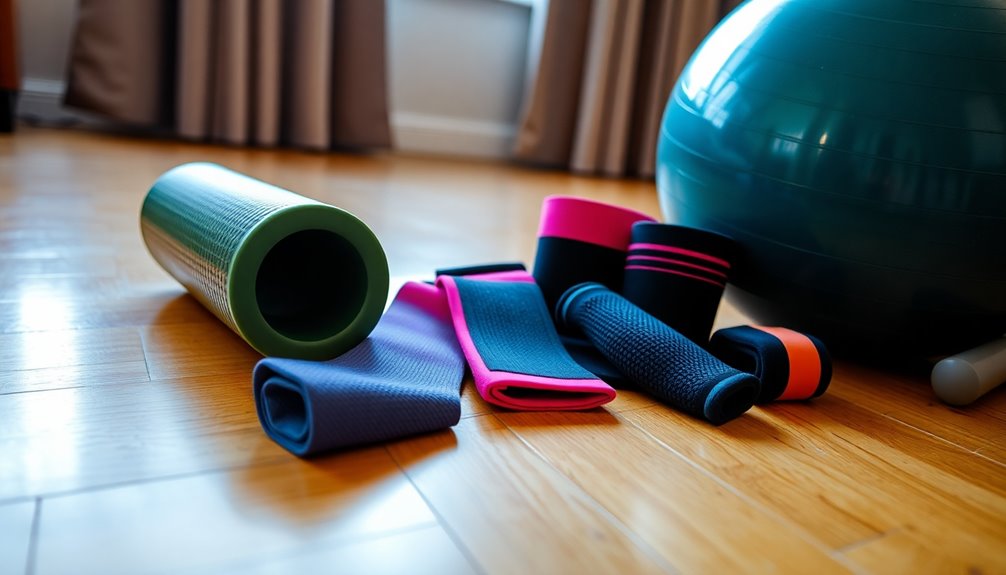
When I choose runner rehabilitation gear, I think about my specific injury type and how it affects my needs. Fit and comfort are essential, as I want to guarantee I can move freely without irritation. Additionally, evaluating the material quality and adjustability helps me find gear that offers the right support while being easy to use.
Injury Type Consideration
Choosing the right rehabilitation gear can greatly impact your recovery, especially since different injuries require specific support and equipment. For instance, if you're dealing with a knee injury, a brace that offers compression and stability can be invaluable. On the other hand, upper body injuries might need equipment that allows for low-impact exercises to avoid further strain. I've found that compression gear is particularly helpful for muscle strains, as it boosts blood circulation and reduces swelling after intense runs. If you're recovering from lower limb injuries, consider a pedal exerciser to help rebuild strength safely. Always consult with a healthcare professional to identify the best gear tailored to your injury type and severity for ideal recovery.
Fit and Comfort
Finding the right fit and comfort in rehabilitation gear is essential for an effective recovery. I've learned that a snug fit is vital; proper compression supports muscles and joints while preventing discomfort and chafing. Look for adjustable features, like straps and lengths, to customize the fit to your body type, enhancing comfort during use. Breathable, moisture-wicking materials can also greatly boost comfort, especially in warmer conditions or during extended wear. The design should allow a full range of motion, avoiding any restrictions while still providing necessary support for rehabilitation exercises. I often check user reviews, and many emphasize the importance of a comfortable fit, recommending products that maintain shape and elasticity after multiple uses for consistent performance.
Material Quality Assessment
After guaranteeing fit and comfort, the next step is evaluating material quality for runner rehabilitation gear. I always prioritize durability and moisture resistance; materials like closed-cell foam or neoprene really enhance both longevity and comfort. Breathability is another factor I can't overlook, as it helps reduce moisture buildup and irritation during long rehab sessions. I also assess compression capabilities since adjustable compression can markedly aid in recovery by promoting blood flow. Lightweight and flexible materials are essential too, allowing for a full range of motion during exercises. Finally, I consider ease of cleaning; gear that's machine washable and wear-resistant guarantees I get better long-term usability, making my rehabilitation process smoother and more effective.
Adjustability and Support
When it comes to selecting runner rehabilitation gear, adjustability and support are essential factors that can make a significant difference in your recovery journey. I've found that adjustable straps and resistance settings allow me to customize the fit and support according to my specific needs. This adaptability not only accommodates various body types but also lets me progressively increase difficulty as my strength improves. Supportive structures, like reinforced stabilizer rings in braces, help maintain proper joint alignment, minimizing the risk of further injury. It's important to have gear that I can modify as I progress through different recovery stages. When I can easily adjust my equipment, I'm more likely to engage consistently, leading to better outcomes in my rehabilitation.
Ease of Use
Choosing runner rehabilitation gear that’s easy to use can greatly enhance your recovery experience. When I select gear, I prioritize how quickly I can set it up, especially if I have limited mobility. User-friendly designs with adjustable straps make a world of difference, allowing me to customize my comfort. I also appreciate gear that comes with clear instructions or video tutorials; they help me operate the equipment correctly and safely. Lightweight materials are a bonus, making it easier to transport and use during rehab sessions. Finally, I evaluate products that allow simultaneous use of different features, ensuring they’re stable. If the equipment wobbles, it can hinder my exercises and overall progress. Moreover, I love exploring innovative recovery gear options that incorporate the latest technology to facilitate healing. For instance, some devices offer features like heat therapy or vibration settings, which can significantly enhance muscle recovery and alleviate soreness. It’s also encouraging to see brands focusing on ergonomic designs, ensuring that the gear not only supports my rehabilitation but also promotes proper body alignment.
Durability and Longevity
While ease of use is important, I can't overlook the durability and longevity of runner rehabilitation gear. When I'm choosing gear, I pay close attention to materials like high-density foam or neoprene, as they hold up well over time. I also look for products that have undergone rigorous testing, ensuring they can handle regular wear and tear, especially in high-impact or moisture-rich environments. Features like moisture resistance are a must for me, as they protect against sweat and water damage. I appreciate positive customer feedback on durability, since reviews often mention long-term performance. Finally, I prefer items that are easy to clean, as maintaining them keeps them fresh and extends their life considerably.
Price and Value
Understanding the price and value of runner rehabilitation gear is essential, especially since I want to make a smart investment. When I assess gear, I always consider the price relative to the quality and durability of materials. Higher-priced options often last longer and perform better. Customer reviews also play a big role; I look for high ratings to gauge satisfaction. It's vital to evaluate the gear's functionality—if it offers multiple uses or specialized features, I might justify a higher cost. I also check for warranties or return policies, which provide extra assurance. Finally, I compare prices across different retailers to find the best deal, as there can be significant price variations for similar products.
Recommended Exercises Integration
When considering runner rehabilitation gear, I find it's crucial to integrate recommended exercises that align with my recovery goals. Low-impact workouts, like aquatic exercises or stationary cycling, help me rehabilitate while minimizing stress on my joints. I also prioritize resistance training tools, such as water weights and foam rollers, to boost my muscle strength and flexibility. Incorporating balance and stability exercises with balance boards has improved my coordination, reducing the risk of future injuries. Stretching routines using resistance bands or stretching straps enhance my flexibility and promote quicker muscle recovery. Finally, I track my progress with journals or built-in monitors to stay motivated and effectively assess my rehabilitation journey. These integrations make a significant difference in my recovery process.
Frequently Asked Questions
How Do I Choose the Right Size for Compression Gear?
Choosing the right size for compression gear is essential. I always start by measuring my body, focusing on areas like my thighs, calves, or waist, depending on the garment. Then, I compare those measurements to the brand's sizing chart. Some brands fit differently, so I read reviews to see how others felt about the sizing. It's all about finding that snug yet comfortable fit that supports me without restricting movement.
Can Rehabilitation Gear Be Used for Injury Prevention?
I believe rehabilitation gear can definitely help with injury prevention. When I use compression sleeves or supportive braces, I notice they provide extra stability and support to my muscles and joints. This added support helps me maintain proper form and reduces the risk of overexertion. While nothing guarantees injury prevention, incorporating the right gear into my training routine has made a noticeable difference in how my body feels during and after workouts.
What Is the Best Way to Clean My Rehabilitation Gear?
Cleaning my rehabilitation gear is like tending to a garden; neglect can lead to weeds of bacteria. I usually start by checking the care instructions for each item. For most fabric gear, I toss them in the washing machine on a gentle cycle with cold water. For hard surfaces, I wipe them down with disinfectant wipes. Regular cleaning keeps my gear fresh and ready for the next round of recovery!
How Long Should I Use Rehabilitation Gear Daily?
I've found that using rehabilitation gear daily really depends on my specific needs and recovery goals. Generally, I aim for at least 30 minutes to an hour each day, but I listen to my body. Some days, I might need more time, while others, I might take a break. It's all about finding that balance that helps me heal without overdoing it. Consistency is key, but rest is just as important!
Are There Specific Exercises Recommended With Rehabilitation Gear?
I remember the first time I slipped on my rehabilitation gear, feeling a mix of hope and uncertainty. There are definitely specific exercises I recommend. For instance, using resistance bands for leg lifts and ankle circles can really help strengthen those muscles. I also love incorporating balance exercises with stability boards. These movements not only aid recovery but also keep me engaged and motivated to push through. Trust me, you won't regret it!
Conclusion
Incorporating the right rehabilitation gear can be a game-changer, helping you bounce back like a rubber band after a tough injury. Each piece of equipment serves a unique purpose, tailored to support your recovery journey. Whether you're looking for support, comfort, or versatility, there's something on this list to meet your needs. So, gear up, stay motivated, and remember that every step you take brings you closer to hitting the pavement again. You've got this!
